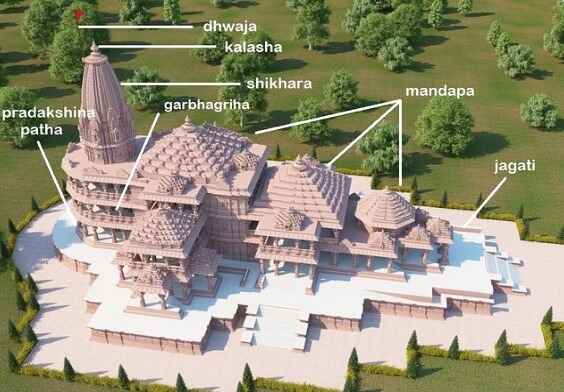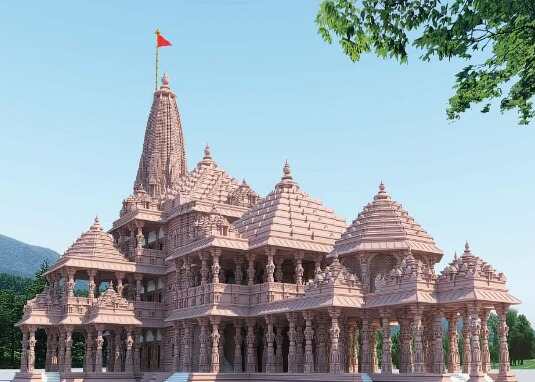Ayodhya, the Ram Janmabhoomi, is gleaming for the gigantic event in its history. The inauguration of the celebrated “Ram Mandir‘ in Ayodhya is said to be organised on January 22, 2024, and has become more than a religious event. It has become a mix of faith, politics and global representation. On the same day, the ‘Pran Pratistha’ ceremony of Lord Ram’s idol will also take place.
The inauguration has led to a massive craze among all the Indians and there is a festive fervour across the country. Invitations have begun with more than 7,000 guests, including 3,000 VVIPs, marking the historic event with widespread participation.
Historical background and legal resolution
The Ayodhya dispute centred around the Babri Masjid, has been a contentious issue for decades. The legal battle and social tensions that surrounded the site have been a defining aspect of India’s socio-political fabric. In 1992, the Babri Mosque was demolished and it raised a worldwide storm of hatred and violence.
However, the Supreme Court of India’s landmark decision in 2019 paved the way for the construction of Ram Mandir, settling the dispute by allocating the contested land for the temple. The judgement aimed at fostering harmony and resolution after years of legal battles.
Cultural and spiritual significance
The Ram Mandir in Ayodhya holds immense cultural and spiritual significance for Hindus. The completion of the Mandir is seen as a symbol of cultural continuity and religious identity. It is considered a sacred site where devotees can connect with the divine and seek blessings.
Lord Rama‘s life, as depicted in the epic Ramayan, is a source of moral and ethical guidance for many, making the temple a symbol of righteousness and dharma. The construction also reflects a sense of cultural restoration and national pride for those who associate with the historical and religious surrounding Ayodhya.
Architectural marvel
The design of Ayodhya’s Ram Mandir blends traditional and modern architectural elements. The original design of Ram mandir was created by the Ahmedabad-based Sompura Family in 1988, however, some changes were made in the year 2020. It is been built in the ’ Nagara’ style of temple architecture. The family has designed the Birla Temples all across the country. The three-story temple is said to be overall 161 feet tall, with dimensions of 380 feet in length and 250 feet in width.
The foundation of the temple incorporates bricks inscribed with Sri Rama’, collected from different parts of the country three decades ago, adding a unique touch. The temple also showcases a commitment to environmental sustainability with a large green area filled with hundreds of trees. The complex is designed to be “Atmanirbhar” or self-reliant, featuring sewage and water treatment plants, a fire brigade post, and a dedicated power line.
Five mandapas namely, Kudu, Nritya, Rang, Kirtan and Prathana, adorned with Shikhara add to the masterpiece of the temple. A total of 366 columns, each housing 16 idols, intricately depict the incarnations of Shiva, Dashavataras, Chausath Yoginis, and goddess Saraswati. Larsen & Toubro, moved by the spiritual significance of the project, volunteered to oversee the design and construction of the temple free of cost.

Over 4,000 workers, including 460 craftsmen, have dedicated their efforts to preparing the temple’s ground floor for the consecration ceremony. Innovative measures, such as 200KA light arresters tested for the first time in India, ensure the safety of pilgrims and the preservation of the temple architecture. From construction materials to amenities and unique techniques, the temple is said to be a marvellous piece of art.
Economic impact
The construction of the Ram Mandir has also stimulated economic activities in Ayodhya and its surrounding areas. The development of infrastructure, tourism facilities, and related industries has boosted the local economy. Many officials are expecting 4.5 million tourists a month, which is more than Ayodhya‘s entire population of 3.5 million. Tata Groups IHCL had signed to construct two luxury hotels.
Praveg Limited, a small cap stock has announced the opening of Tent City at Ayodhya, starting from 15th January. Almost 75% of occupancy is pre-sold. Ayodhya‘s new airport and railway station has been inaugurated by the Prime minister on 30 December 2023. Indigo is the first airline to start direct flights to Ayodhya. Recently, they announced daily Mumbai to Ayodhya flights from January 15. The Indian Railways is set to run 1000+ trains to Ayodhya from all across the country.
IRCTC and even other railway stocks, hotels, tour operators, airlines, infra stocks, automobiles, FMCG, etc. can benefit greatly from Ram Mandir’s opening. There has been a rapid pace of development in the tranquil temple town. New airports, wifi zones, a Ramayana theme Park, and recreational activities are adding to the tourism of the state and the country as a whole.
Prior tourism footfall in the state was largely restricted to local pilgrims from the neighbouring towns and villages. Popular fairs and festivals like Ram Navami, Rath Yatra, Ram Vivah etc only attracted tourists. Even there’s a good business for those who apply tika on the foreheads of the devotees. With the inauguration, the state has become a New Investing Theme.
Development and infrastructure projects have been categorised into eight themes regarding Ayodhya– Aesthetic, Clean, Efficient, Accessible, Experiential, Modern, Cultural and Healthy. With a high number of developmental projects, the state will turn into a powerhouse boosting the business and economic activities in the entire region. It will also become a hub for regional growth with enhanced connectivity.
Cultural extravaganza during the inauguration
Preparing for a cultural extravaganza at Ram Mandir would involve various performances, cultural activities, and religious ceremonies. A 108-foot-long incense stick weighing 3,610 kg and almost 3.5 feet wide, has been prepared in Gujarat’s Vadodarsa over six months for Ram Mandir. More than 3,000 gifts from Janakpur in Nepal, Sita’s birthplace, have arrived in Ayodhya for Lord Rama.
A Sri Lankan delegation presented a rock from the Ashok Vatika. Gujarat Chief Minister Bhupendra Patel flagged off a 44-foot-long-brass flag pole and six smaller flag poles in Ahmedabad for the “Pran Pratisha” Ceremony. The world’s largest lock and key has been prepared and gifted to the temple. A bell, which took two years to prepare, weighing 2,100 kg of ‘Asthadhatu’, has also arrived at the temple.
A clock that denotes time in eight countries at the same time is prepared by a Lucknow-based vegetable vendor, measuring 75 cm in diameter has been received by the General Secretary of the temple trust. Besides this, a lot has been done by the people from various parts of the country with pure enthusiasm and devotion for the inauguration of Ram Mandir.

Conclusion
Like other Agrarian Societies, religion has been an integral part of life in India. Religious Shrines, however, have a checkered history. In such cases The Ram Mandir of Ayodhya not only echoes a monumental presence on the landscape but also eternally imprints itself on the heart of those who witness its majesty.
The construction not only represents the aspiration of the Hindu community but also provides a step toward fostering harmony and understanding among India’s diverse population. The journey from Controversy to Construction reflects the resilience of India’s democratic and judicial institutions in addressing complex socio-religious issues.
-TANYA SHAH
MUST READ: DONKEY FLIGHT: THE PERILOUS JOURNEY OF ILLEGAL IMMIGRANTS TO THE WEST


